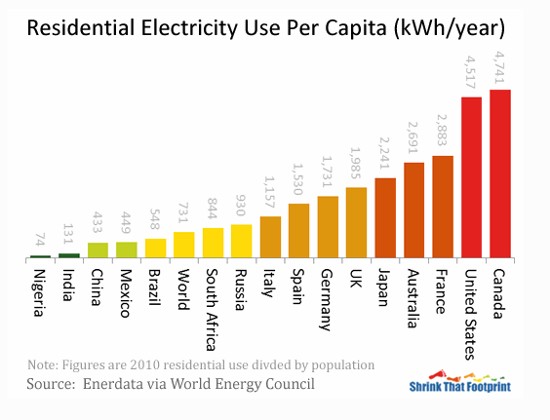Yesterday I attended an online discussion about the challenges that the energy industry faces in meeting the aspirational net-zero emissions goal that was discussed at COP26 and is prominently described in every IPCC report issued by the United Nations. One speaker described the goal as being “a Western conceit.” What did he mean by that?
The challenge for most poor nations is to have some electricity to keep machines operating and the lights on. Today, approximately 80% of the planet has access to electricity. For example, in 2010, only 66% of Indian and 50% of Nigerian households had electricity. Those with no access continue to shrink but not by much. And when you compare what Indian and Nigerian homes consume (see the graph below) versus American or Canadian homes it becomes clearer why the speaker could make the Western conceit comment.
 It’s a big ask to tell countries with very little access to electricity to accept the same level of responsibility as electricity-rich nations striving to achieve the net-zero emissions target that the United Nations has set for the mid-century.
It’s a big ask to tell countries with very little access to electricity to accept the same level of responsibility as electricity-rich nations striving to achieve the net-zero emissions target that the United Nations has set for the mid-century.
It was proposed that one solution could be for Global South countries to skip building the same kind of electrical-power infrastructure that richer nations already have. The example used was how African countries bypassed building landline telecommunications and went directly to mobile cellular networks and smartphones rather than stringing telephone poles and wires across their countries. Similarly, these countries could bypass the building of thermal power plants and national grids and instead rely on local power distribution models fueled by renewable sources backed by baseload modular small nuclear reactors and large-scale energy storage to overcome intermittency issues.
Nuclear was central to much of the Foreign Policy online discussion. A speaker from Emirates Nuclear Energy Corporation (ENEC) used the example of the UAE’s new Barakah nuclear power plant to demonstrate how an oil-rich country could transition to a clean energy future with this type of zero-emission facility.
The Russian invasion of Ukraine was used to explain how the European Union’s aggressive goal setting on emission reductions could be upset dramatically by external events. In many EU countries, the closing of coal-fired power plants as well as nuclear power facilities has left utilities almost exclusively reliant on Russian fossil fuel sources or having to restart decommissioned coal and nuclear plants. Coal is easier to get up and running. Nuclear not so much.
Throughout the online event which included people from the nuclear industry and consultants to energy companies, the focus on nuclear was largely on the technologies in current use in France, the United States, and China. There was a brief chat about smaller modular nuclear power when a question from viewers asked could a city set up its own distributed energy cluster of mixed solar, wind and some geothermal, with a modular reactor for baseload power. None of the panellists saw this in the near future.
I sent in several questions of which none were answered. I wanted to know what these experts were thinking about nuclear fusion (see previous postings on this subject on this site) and the timelines for its emergence. And I also asked about alternative fission reactor technologies that are suddenly being introduced.
On the subject of nuclear power, concern about the exposure of Ukraine’s plants to Russian military incursions was raised. The general consensus was that the risk of radiation contamination so far was minimal to non-existent. But an article in yesterday’s Bulletin of the Atomic Scientists disagrees. Jungmin Kang, a South Korean member of the International Panel on Fissile Materials, and Eva Lisowski, who is a participant in the MIT Nuclear Weapons Education Project, are the authors.
The attacks that occurred at Chernobyl and Zaporizhzhya damaged external buildings, not those containing the reactors themselves. But even attacks on outbuildings have consequences. Fires can spread and lead to damage to power backup systems which could impact the circulation of coolants within the reactors themselves. And if a reactor is shut down and left in non-operational mode, if cooling pumps have no power because backup generators are damaged, then even the spent fuel becomes a danger that could lead to a fire releasing radioactive contaminants.
Why the Russian military targeted two nuclear reactor facilities in Ukraine shows reckless ignorance. Do Russian soldiers not have a memory of the consequences of Chernobyl? How could they enter an exclusion zone that has been off-limits to people since December 1986? Why would they track tanks and troop transports through contaminated soils covering the 2,600 square kilometres around the reactor site?
One of the speakers at the Foreign Policy online event stated he was more concerned about the Russian bombing of a Ukrainian chemical plant that led to an ammonia leak. Hearing that I just shook my head. Why? Because to this day, the meltdown of Chernobyl’s Reactor 4 because of human operational errors, is not fully accounted for in terms of human long-term health effects. And final cleanup of the site in Ukraine wasn’t scheduled for completion until 2065.
Kang and Lisowski don’t pull any punches. They note that a war that envelops areas where nuclear power plants are operating can only have negative consequences. Missiles and artillery could lead to the breach of a building’s shell and damage to both primary and secondary cooling and safety systems. The cascade of consequences could be immeasurable and last decades if not centuries.
At the conclusion of the Foreign Policy online event, for all the opinions raised that I couldn’t agree with, the one conclusion I could concur with was that nuclear power will be essential in the mix for us to achieve net-zero emissions by 2050. But I don’t believe it will be the legacy nuclear power plants helping us to meet the goal. Instead, a next-generation nuclear industry that is moving out of planning and off the drawing boards right now will provide us with a safe solution.









